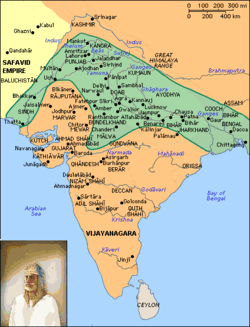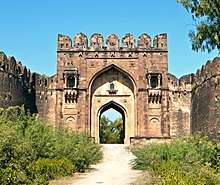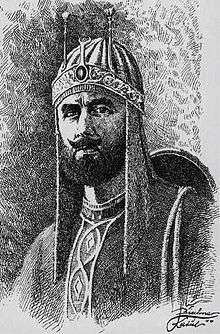Sur Empire
| Sur Empire | |||||||||
|---|---|---|---|---|---|---|---|---|---|
| 1532–1556 | |||||||||
 Territory of Sur Empire in green | |||||||||
| Capital | Sasaram (Bihar) | ||||||||
| Common languages | Pashto, Hindavi[1] | ||||||||
| Religion | Sunni Islam | ||||||||
| Government | Sultanate | ||||||||
| History | |||||||||
• Established | 17 May 1532 | ||||||||
• Disestablished | 1556 | ||||||||
| |||||||||
| Today part of |
| ||||||||
The Sur Empire was an empire established by a Muslim dynasty of Afghan(Pashtun)[2] origin who ruled a large territory in northern part of the Indian subcontinent for nearly 16 years,[3] between 1540 and 1556, with Sasaram in modern-day Bihar serving as its capital.[3]
History

The empire was founded by Sher Shah Suri, an ethnic Afghan of the tribal house of Sur,[3] who supplanted the Mughal dynasty as rulers of North India during the reign of the relatively ineffectual second Mughal Humayun. Sher Shah defeated badshah-i-Hind ('Hindustani emperor') Humayun in the Battle of Chausa (26 June 1539) and again in the Battle of Bilgram (17 May 1540).[4]
The Sur dynasty held control of nearly all the Mughal territories, from modern-day eastern Afghanistan in the west to Bengal in modern-day Bangladesh in the east.
During the almost 17-year rule of the Sur dynasty, until the return of the Mughals to the throne, the region of the South Asia witnessed much economic development and administrative reforms. A systematised relationship was created between the people and the ruler, minimising corruption and the oppression of the public.
Their rule came to an end by a defeat that led to restoration of the Mughal Empire.
It was at the time of this bounty of Sultán Bahlol [Lodi], that the grandfather of Sher Sháh, by name Ibráhím Khán Súr,*[The Súr represent themselves as descendants of Muhammad Súr, one of the princes of the house of the Ghorian, who left his native country, and married a daughter of one of the Afghán chiefs of Roh.] with his son Hasan Khán, the father of Sher Sháh, came to Hindu-stán from Afghánistán, from a place which is called in the Afghán tongue "Shargarí,"* but in the Multán tongue "Rohrí." It is a ridge, a spur of the Sulaimán Mountains, about six or seven kos in length, situated on the banks of the Gumal. They entered into the service of Muhabbat Khán Súr, Dáúd Sáhú-khail, to whom Sultán Bahlol had given in jágír the parganas of Hariána and Bahkála, etc., in the Panjáb, and they settled in the pargana of Bajwára.[5]
— Abbas Khan Sarwani, 1580
List of Sur dynasty rulers

| Name | Picture | Reign started | Reign ended |
|---|---|---|---|
| Sher Shah Suri |  |
17 May 1532[8] | 22 May 1545[8] |
| Islam Shah Suri | 26 May 1545[9] | 22 November 1554[9] | |
| Firuz Shah Suri | 1554[10] | ||
| Muhammad Adil Shah | 1554[10] | 1555[11] | |
| Ibrahim Shah Suri | 1555[11] | 1555 | |
| Sikandar Shah Suri | 1555[11] | 22 June 1555[11] | |
| Adil Shah Suri | 22 June 1555[11] | 1556[11] |
See also
References
- ↑ Alam, Muzaffar (1998). "The pursuit of Persian: Language in Mughal Politics". Modern Asian Studies. Cambridge University Press. 32 (2): 317–349. doi:10.1017/s0026749x98002947.
Hindavi was recognized as a semi-official language by the Sor Sultans (1540-55) and their chancellery rescripts bore transcriptions in the Devanagari script of the Persian contents. The practice is said to have been introduced by the Lodis (1451-1526).
- ↑ Singh, Sarina; Lindsay Brown; Paul Clammer; Rodney Cocks; John Mock (2008). Pakistan & the Karakoram Highway. 7, illustrated. Lonely Planet. p. 137. ISBN 1-74104-542-8. Retrieved 23 August 2010.
- 1 2 3 Kissling, H. J.; N. Barbour; Bertold Spuler; J. S. Trimingham; F. R. C. Bagley; H. Braun; H. Hartel (1997). The Last Great Muslim Empires. BRILL. pp. 262–263. ISBN 90-04-02104-3. Retrieved 20 July 2011.
- ↑ "Sher Khan". The Columbia Electronic Encyclopedia, 6th edition. Columbia Encyclopedia. 2007. Retrieved 25 August 2010.
- ↑ Abbas Khan Sarwani (1580). "Táríkh-i Sher Sháhí; or, Tuhfat-i Akbar Sháhí, of 'Abbás Khán Sarwání. CHAPTER I. Account of the reign of Sher Sháh Súr". Packard Humanities Institute. Retrieved 4 September 2010.
- ↑ Mughal Coinage Archived 16 May 2008 at the Wayback Machine. Reserve Bank of India RBI Monetary Museum,
- ↑

- 1 2 Majumdar, R.C. (ed.) (2007). The Mughul Empire, Mumbai: Bharatiya Vidya Bhavan, ISBN 81-7276-407-1, p.83
- 1 2 Majumdar, R.C. (ed.) (2007). The Mughul Empire, Mumbai: Bharatiya Vidya Bhavan, ISBN 81-7276-407-1, pp.90–93
- 1 2 Majumdar, R.C. (ed.) (2007). The Mughul Empire, Mumbai: Bharatiya Vidya Bhavan, ISBN 81-7276-407-1, p.94
- 1 2 3 4 5 6 Majumdar, R.C. (ed.) (2007). The Mughul Empire, Mumbai: Bharatiya Vidya Bhavan, ISBN 81-7276-407-1, pp.94–96
| Wikimedia Commons has media related to Suri Empire. |